Vines Plants with Red Flowers make a striking statement that is difficult to ignore and make a lovely focal point in any garden.
Are you considering introducing a red-blooming vine to your garden but unsure where to begin? There are many options for a red-flowering vine, and many of them need more assistance to climb. Let’s have a look at 17 striking red flowering vines that can give life to your spring flower garden.
1. Red Climbing Roses
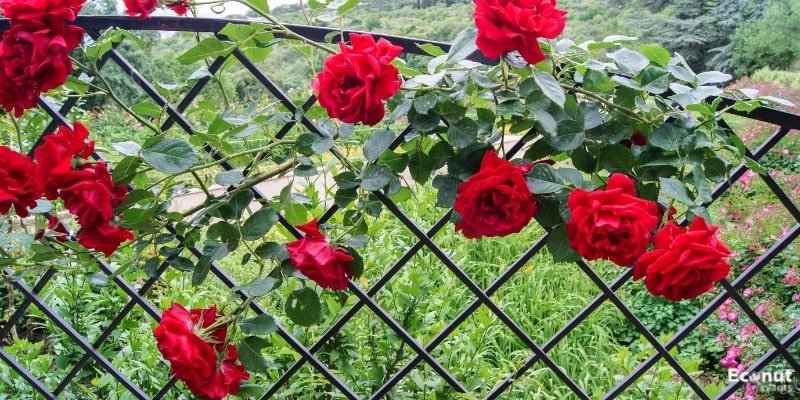
Scientific Name: Rosa santana
Plant Type: Perennial shrub
Sun Exposure: Full Sun
Plant Size: 6-8 feet high, 3-4 feet wide
Plant Zone: 6-8
Another similar-looking vine-like climbing shrub with red blossoms is this one. When paired with glossy, dark green leaves, Santana roses, which are red roses with a delicate, romantic scent, can be quite stunning.
Eight to ten centimeters in diameter, red climbing roses are hybrid tea roses. With large clusters of ruby red roses on display for the entire world to see, the blooms blossom between early spring and late autumn.
Although it can grow in about any kind of soil, this hybrid rose variety thrives in a sunny, protected area. Both downy mildew and blackspot are somewhat resistant to these climbing roses.
2. Red Morning Glory
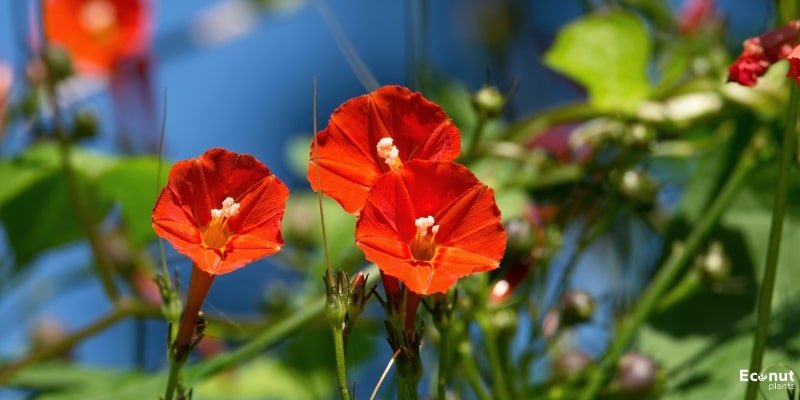
Scientific Name: Ipomoea coccinea L.
Plant Type: Annual vine
Sun Exposure: Full Sun
Plant Size: 8-12 feet tall, 5-20 feet wide
Plant Zone: 9-11
Common names for the Red Morning Glory include Scarlet Morning Glory, Scarlet Creeper, and Star Ipomoea. It is an annual herbaceous vine. The plant bears colourful trumpet-shaped flowers and heart-shaped leaves in various shapes and sizes.
3. Cypress Vine

Scientific Name: Ipomoea quamoclit L.
Plant Type: Annual vine
Sun Exposure: Full Sun
Plant Size: 6-15 feet tall
Plant Zone: 10-11
A magnet for hummingbirds, this gorgeous annual climbs quickly! Under full sun on a trellis or arbour, it looks lovely with delicate tubular flowers of red, pink, or apricot and feathery foliage.
4. Cross Vine
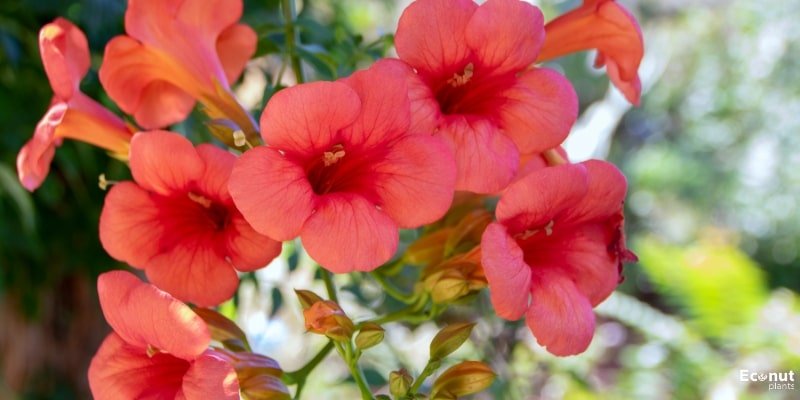
Scientific Name: Bignonia capreolata L.
Plant Type: Semi-evergreen vine
Sun Exposure: Full Sun
Plant Size: 30-50 feet tall, 6-9 feet wide
Plant Zone: 6-9
“Cross vine” should be crossed off your to-grow list if you’re trying to add an orangey-red pop to your garden! This woody vine will cover the building it grows on in late spring and summer with its striking red, orange, and yellow blossoms and deep green leaves.
It can be kept within reasonable bounds by pruning its vines by chopping them back by half or more after they finish blooming, as its vibrant blossoms also draw hummingbirds.
5. Cardinal Climbers vine

Scientific Name: Campsis radicans
Plant Type: Perennial vine
Sun Exposure: Full Sun
Plant Size: 10-15 feet tall
Plant Zone: 3-11
Cardinal climbers are a stunning blooming vine worth checking into if you want to add a striking splash of crimson to your landscape.
As they bloom from mid-summer through October, cardinal climbers are a desirable choice, according to Sears, because they generate an abundance of tiny, deep, scarlet-coloured trumpets.
6. Trumpet Vine
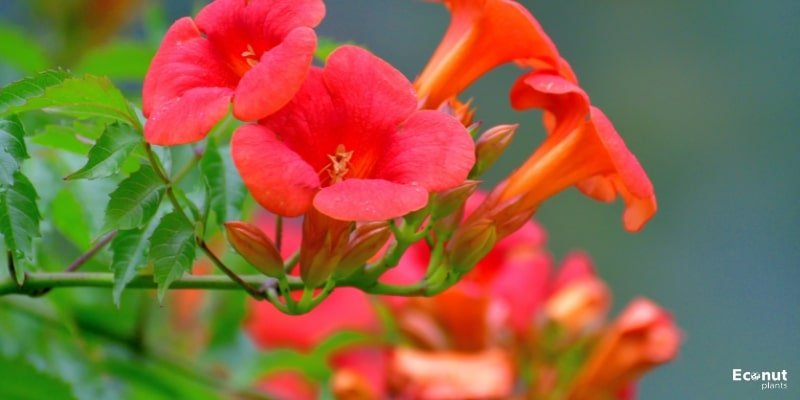
Scientific Name: Campsis radicans
Plant Type: Perennial vine
Sun Exposure: Full Sun
Plant Size: 30-40 feet high
Plant Zone: 4-9
Hummingbirds are drawn to this deciduous climbing vine. Clusters of enormous, tubular, deep reddish-orange flowers on Balboa Sunset Trumpet Vine provide for a striking display throughout the growing season.
After the vine is well established, it grows quickly and blossoms abundantly while receiving almost no care. Use it as a ground covering or to screen a fence or lattice.
7. Bleeding Heart Vine
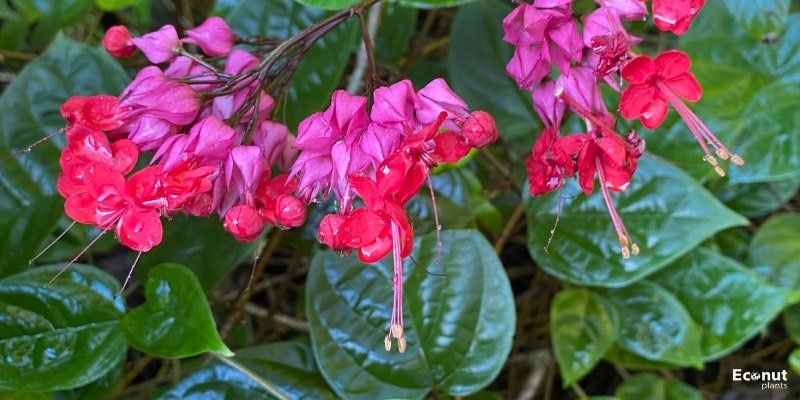
Scientific Name: Clerodendrum thomsoniae
Plant Type: Perennial vine
Sun Exposure: Full Sun, Partial Sun
Plant Size: 15 feet tall
Plant Zone: 9-12
The evergreen bleeding heart vine twines itself beautifully, bearing large white blooms with crimson highlights. With ease, the vine may wrap around a support structure, reaching a maximum length of 15 feet.
Growing these vines requires maintaining a regularly damp but not soggy soil. In addition, they require frequent fertilization during the growing season because they are heavy eaters.
8. Bougainvillea
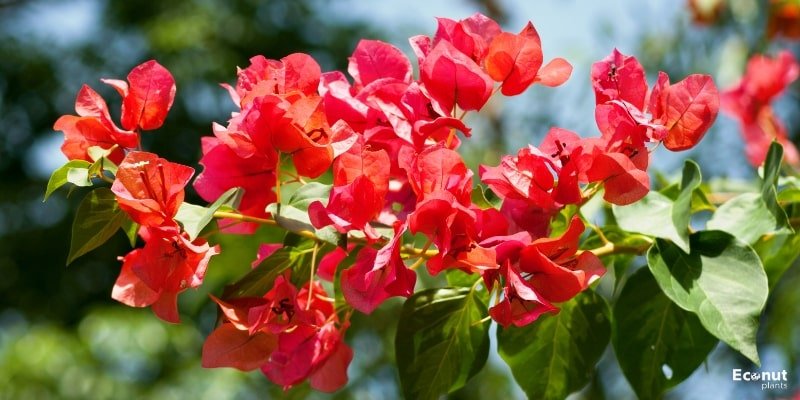
Scientific Name: Bougainvillea spectabilis
Plant Type: Evergreen vine
Sun Exposure: Full Sun
Plant Size: 40 feet tall
Plant Zone: 9-11
A profusion of neon-bright, papery-thin “flowers,” which are actually multi-coloured bracts, are produced by this flowering vine. Nestled within are the little, white genuine blooms. Acidic soil is necessary for this sun-loving, drought-tolerant plant. When trained up the side of a home in the South, bougainvillea can grow to be rather large.
9. Lipstick Plant

Scientific Name: Aeschynanthus radicans
Plant Type: Evergreen vine
Sun Exposure: Full Sun
Plant Size: 3 feet tall
Plant Zone: 10-11
This evergreen plant derives its name from its eye-catching, lipstick-like blossoms, which have a tube-like appearance. Native to Malaysia’s tropical regions, this plant does best indoors in a bright spot with indirect sunshine and away from drafts.
Give the vines ample space to stretch out, and this plant will produce an abundance of blooms all year when planted in a compact flower pot.
Since lipstick plants tend to have root rot, make sure to plant them in well-draining soil and water them only until the earth feels completely dry. As soon as every bud has flowered, make sure to prune frequently.
10. Firecracker
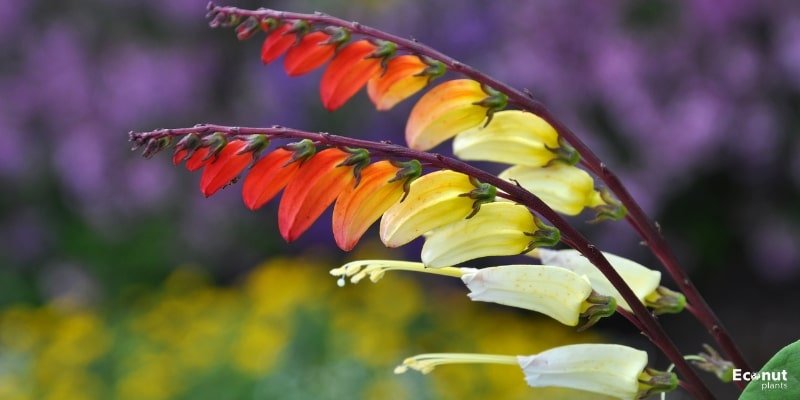
Scientific Name: Ipomoea lobata
Plant Type: Annual vine
Sun Exposure: Full Sun
Plant Size: 3-4 feet tall
Plant Zone: 10-11
Red to pale yellow, firecracker vines come in a range of flaming colours. Some gardeners sometimes refer to this perennial vine, which may reach a height of 16 feet, as the Spanish flag. Hummingbirds and butterflies find it extremely appealing.
11. Red Climbing Fuchsia
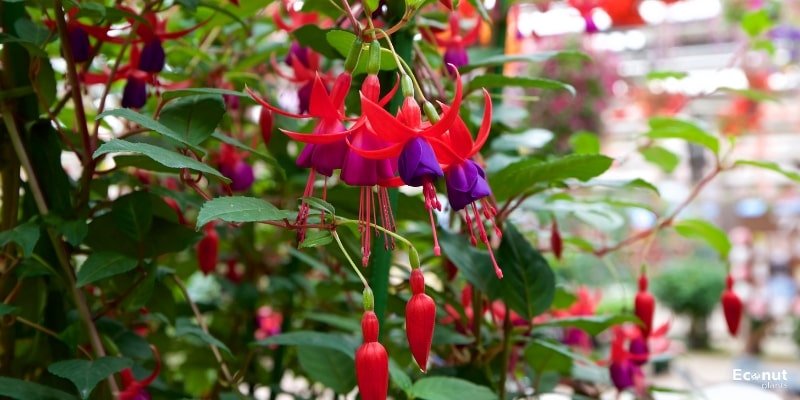
Scientific Name: Fuchsia magellanica
Plant Type: Perennial semi-climbing shrub
Sun Exposure: Full Sun, Partial Shade
Plant Size: 2-10 feet tall
Plant Zone: 6-9
While fuchsia plants can also be used as garden accents, they are not actually vines with red blooms, even though they grow similarly. Blooming from summer to October, the shrubs bear pendant-shaped blooms.
Beautiful red blossoms adorn this robust vine, which can withstand harsh winters better than other fuchsia plants. It may grow in either full sun or moderate shade, and it does best in soil that is wet and well-drained.
Butterfly, bee, and moth attraction is well-known due to the pollen-rich flowers of the shrub. Additionally, caterpillars rely heavily on the plant as a food source.
12. Coral Honeysuckle Vine

Scientific Name: Lonicera sempervirens L.
Plant Type: Perennial vine
Sun Exposure: Full Sun, Partial Shade
Plant Size: 15-25 feet tall
Plant Zone: 4-11
Honeysuckle vines are climbing perennials that prefer a northern temperature despite their seemingly tropical, long, tubular blossoms. The fragrant scent, nectar-rich blossoms that draw hummingbirds, and ease of maintenance are among the common traits shared by many varieties of honeysuckle vines.
You can appreciate the beautiful yellow, white, orange, or red blooms of the honeysuckle vine whether it is clinging to a sturdy post, fence, or arbour.
13. Scarlet Runner Bean
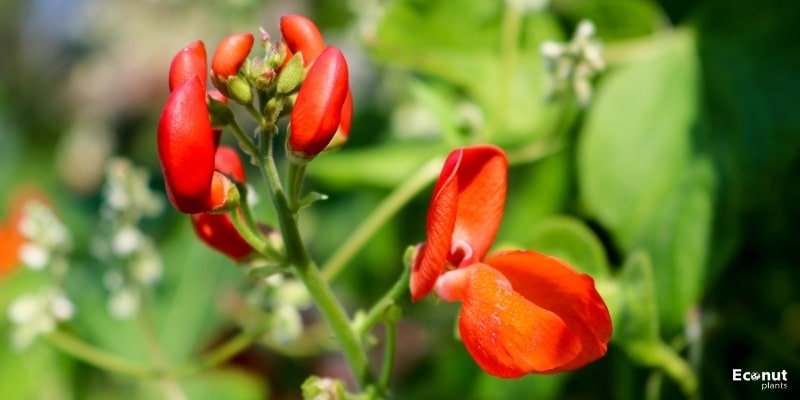
Scientific Name: Phaseolus coccineus
Plant Type: Perennial vine
Sun Exposure: Full Sun
Plant Size: 8-12 feet tall
Plant Zone: 7-11
Hummingbirds are drawn to the stunning crimson blossoms of this ancestral vine. Better yet, you can eat the beans. When they are little, you can eat them fresh from the vine; otherwise, you can wait until the end of the season to harvest them and dry them. Give it lots of space to expand, because it is a quick grower.
14. Mandevilla
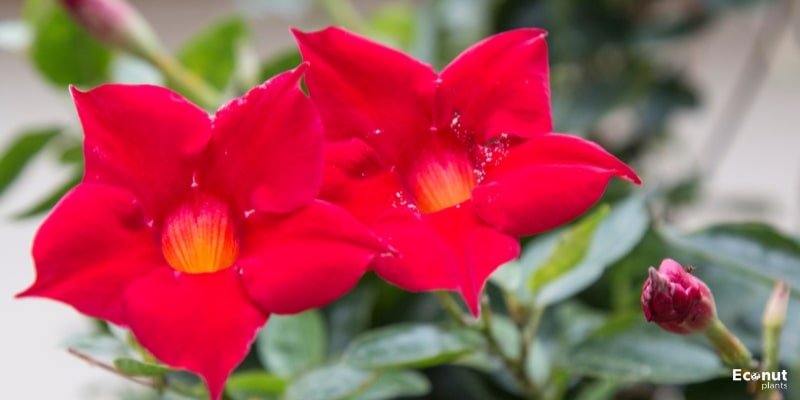
Scientific Name: Mandevilla sanderi
Plant Type: Perennial vine
Sun Exposure: Full Sun
Plant Size: 3-10 feet tall
Plant Zone: 9-11
The glossy foliage contrasts with the white, crimson, or pink blooms on this gorgeous tropical vine. It continuously blooms over the summer. However, provide it with some midday shade in hotter climates.
Before making a purchase, check the plant tag, as some varieties are bushier rather than vine-like. It is regarded as a perennial in warm climates but as an annual elsewhere in the nation.
15. Rangoon Creeper

Scientific Name: Combretum indicum
Plant Type: Perennial vine
Sun Exposure: Full Sun, Partial Shade
Plant Size: 30 feet tall
Plant Zone: 10-11
Bright bunches of flowers adorn the woody vine known as the rangoon creeper. Each spring, these fragrant blooms appear in four- to five-inch clusters that persistently “creep” toward the sun. They make eye-catching accent flowers for gazebos and archways. In a warm, tropical climate, blooms never end.
This vine may grow in a variety of soil types, but it thrives in full sun with some afternoon shade. With its 12 to 15-foot vines, the Rangoon Creeper is a vigorous plant that requires lots of space to spread out.
16. Dwarf Red Jade Vine
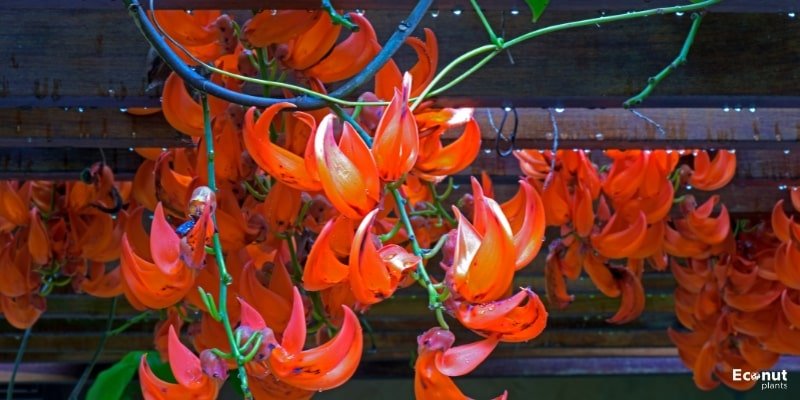
Scientific Name: Camptosema spectabile
Plant Type: Perennial vine
Sun Exposure: Full Sun, Partial Shade
Plant Size: 12-15 feet tall
Plant Zone: 9-11
The dwarf red jade vine is growing quickly and boldly, proclaiming itself. These plants bloom in warmer climates from late fall until spring, when they produce long chains of drooping blooms. Remarkably resilient to low temperatures, it can withstand up to 25 degrees. This seductive native of Brazil can even withstand a little frost.
Since they prefer to have their roots covered, these plants do best in moist, deep soil and behave nicely when mulch is placed around the base. Dwarf red jade can take two to three years to blossom, so success with them depends on lots of direct sunlight, warmer temperatures, and patience.
17. Red Iochroma
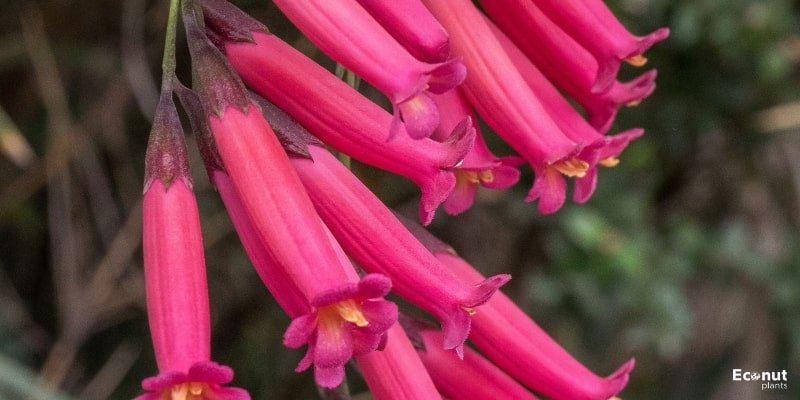
Scientific Name: Iochroma fuchsioides
Plant Type: Evergreen shrub
Sun Exposure: Full Sun
Plant Size: 8-12 feet tall
Plant Zone: 9-10
Hummingbirds are drawn to the red iochroma from a great distance, just like they are to many other vines on our list. They have tubular, bright red flowers and are native to the woods of Mexico and South America.
They are usually utilized as flowering ornamentals, although they are also frequently used as patio shrubs in cooler plant zones. In colder locations, this kind of climbing shrub needs protection throughout the winter because it is not highly resistant to frost.

